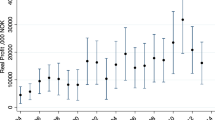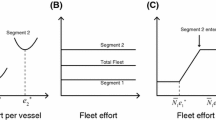Abstract
Over the last three decades most of the world's fisheries have been subject to management programs that have tried to limit the use of key fishing inputs. Inevitably, these restrictions have proven ineffective at preventing rent dissipation and stock depletion. More noteworthy is that fishers have subverted the intentions of these restrictions by adjusting the primary harvesting technology. This has led to an inefficient industrial structure characterized by capital stuffing on the part of each vessel, excess employment, an inefficient mix of vessels in the fleet, and too many vessels altogether.
A promising means of encouraging more efficient primary harvesting is the individual transferable vessel quota that allocates a given catch to each vessel, thereby giving an incentive to catch the quota at least cost. This paper examines efficiency gains and potential industry restructuring from the introduction of an ITVQ into a fishery that was previously subject to input restrictions.
Using data from the British Columbia salmon fishery, this paper estimates restricted cost functions for each of four different vessel types and simulates the operations of a market for ITVQs. The demand for quota comes from individual vessels and is found by differentiating the cost function with respect to the shadow price of quota. The market for quota is in equilibrium when the total demand for quota is equal to the fixed supply of quota set by the government. This implicitly defines the equilibrium quota rental price. Results show that the ITVQ could generate unit rental prices for quota between 31 and 93 cents per pound (18–53% of the average landed price).
Using this simulated price, each vessel's cost‐minimizing strategy is defined and both low cost vessels (those that will buy quota) and high cost vessels (those that will sell quota and exit the fishery) are identified. Quota trades between the two groups result in efficiency gains. These include reduced capital stuffing, exit of less efficient vessel types, attainment of economies of scale, and an efficient composition of vessel types in the fleet. In aggregate these gains lead to an estimate of annual resource rent that is approximately equal to one third of the value of the catch.
Similar content being viewed by others
References
L.G. Anderson, A note on market power in ITQ fisheries, Journal of Environmental Economics and Management 21(3) (1991) 292-296.
L.G. Anderson, An economic analysis of highgrading in ITQ fisheries regulation programs, Marine Resource Economics 9(3) (1994) 209-226.
R. Arnason, On catch discarding in fisheries, Marine Resource Economics 9(3) (1994) 189-207.
J.R. Boyce, Individual transferable quotas and production externalities in a fishery, Natural Resource Modelling 6(4) (1992) 385-408.
K.E. Casey, C.M. Dewees, B.R. Turris and J.E. Wilen, The effects of individual vessel quotas in the British Columbia Halibut fishery, Marine Resource Economics 10(3) (1995) 211-230.
F.T. Christy, Fishermen's quotas: A tentative suggestion for domestic management, Occasional Paper No. 19 of the Law of the Sea Institute, The University of Rhode Island (1973).
C.W. Clark, Towards a predictive model for the regulation of fisheries, Can. J. Fish. and Aquatic Sci. 37 (1980) 1111-1129.
C.W. Clark, Bioeconomic Modelling and Fisheries Management (Wiley, New York, 1985).
I.N. Clark, P.J. Major and N. Mollett, Development and implementation of New Zealand's ITQ management system, Marine Resource Economics 5(4) (1988) 325-350.
P. Copes, A critical review of the individual quota as a device in fisheries management, Land Economics 62(3) (1986) 278-291.
R.W. Crowley and H. Palsson, Rights based fisheries management in Canada, Marine Resource Economics 7(2) (1992) 1-21.
J.A. Crutchfield, Economic and social implications of the main policy alternatives for controlling fishing effort, Journal of the Fisheries Research Board in Canada 36(7) (1979) 742-752.
Department of Fisheries and Oceans Canada, Backgrounder. Restructuring the Pacific Fishery, http:// www.dfo-mpo.gc.ca/communic/BACKGROU/1998/1906 e7.htm (1998).
C. Dewees, Assessment of the implementation of individual transferable quotas in New Zealand's inshore fishery, North American Journal of Fisheries Management 9 (1989) 131-139.
W.E. Diewert, Functional forms for profit and transformation functions, Journal of Economic Theory 6 (1973) 284-316.
W.E. Diewert, The Measurement of the Economic Benefits of Infrastructure Services (Springer, Berlin, 1986).
W.E. Diewert and T.J. Wales, Flexible functional forms and global curvature conditions, Econometrica 55(1) (1987) 43-68.
D.P. Dupont, Rent dissipation in restricted access fisheries, Journal of Environmental Economics and Management 19(1) (1990) 26-44.
D.P. Dupont, Limited entry fishing programs: Theory and Canadian practice, in: Fisheries And Uncertainty: A Precautionary Approach To Resource Management, eds. D.V. Gordon and G.R. Munro (University of Calgary Press, Calgary, 1996) pp. 125-147.
J.R. Gauvin, J.M. Ward and E.E. Burgess, Description and evaluation of the wreckfish (polyprion americanus) fishery under individual transferable quotas, Marine Resource Economics 9 (1994) 99-118.
G. Geen and M. Nayar, Individual transferable quotas in the Southern Bluefin tuna fishery: An economic appraisal, Marine Resource Economics 5(4) (1988) 365-388.
H.S. Gordon, Economic theory of a common-property resource: The fishery, Journal of Political Economy 62 (1954) 124-142.
R.Q. Grafton, Rent capture in a rights-based fishery, Journal of Environmental Economics and Management 28 (1995) 48-67.
R.Q. Grafton and H.W. Nelson, Fishers' individual salmon harvesting rights: An option for Canada's pacific fisheries, Working paper #9604E, University of Ottawa, Department of Economics (1996).
D.W. Jorgenson, Capital theory and investment behaviour, American Economic Review 53 (1963) 247-259.
G.G. Judge, R.C. Hill, W.E. Griffiths, H. L¨utkepohl and T. Lee, Introduction to the Theory and Practice of Econometrics (Wiley, Toronto, 1982).
N. Kulatilaka, Are observed technologies at long-run equilibrium, Journal of Econometrics 25 (1985) 253-268.
K. Laitinen, A Theory of the Multiproduct Firm (North-Holland, Amsterdam, 1980).
R.K. Lindner, H.F. Campbell and G.F. Bevin, Rent generation during the transition to a managed fishery: The case of the New Zealand ITQ system 7(4) (1992) 229-248.
D.G. Moloney and P.H. Pearse, Quantitative rights as an instrument for regulating commercial fisheries, Journal of the Fisheries Research Board in Canada 36 (1979) 859-866.
P. Neher, R. Arnason and N. Mollett, eds., Rights Based Fishing (Kluwer, Netherlands, 1989).
P.H. Pearse, Turning the Tide: A New Policy for Canada's Pacific Fisheries. The Commission on Pacific Fisheries Policy. Final Report (Supply and Services, Ottawa, 1982).
R.B. Rettig, License limitation in the United States and Canada: An assessment, North American Journal of Fisheries Management 4 (1984) 231-248.
W. Schworm, User cost and the demand for capital, Discussion paper 77-22, Department of Economics, University of British Columbia (1977). 294
A.D. Scott, Development of economic theory on fisheries regulation, Journal of the Fisheries Research Board in Canada 36(7) (1979) 725-741.
A.D. Scott, Development of property in the fishery, Marine Resource Economics 5(4) (1988) 289-312.
A.D. Scott and P.A. Neher, The Public Regulation of Commercial Fisheries in Canada (Economic Council of Canada, Ottawa, 1981).
D. Squires, Public regulation and the structure of production in multiproduct industries: An application to the New England otter trawl fishery, Rand Journal of Economics 18(2) (1987) 232-248.
D. Squires, Production technology, costs, and multiproduct industry structure: An application of the long-run profit function to the New England fishing industry, Canadian Journal of Economics 21(2) (1988) 359-378.
D. Squires and J. Kirkley, Production quota in multiproduct pacific fisheries, Journal of Environmental Economics and Management 21 (1991) 109-126.
D. Squires and J. Kirkley, Individual transferable quotas in a multiproduct common property industry, Canadian Journal of Economics 24(2) (1996) 318-342.
D. Squires, M. Alauddin and J. Kirkley, Individual transferable quota markets and investment decisions in the fixed gear sablefish industry, Journal of Environmental Economics and Management 27 (1994) 185-204.
D. Squires, J. Kirkley and C. Tisdell, Individual transferable quotas as a fisheries management tool, Reviews in Fisheries Science 3(2) (1995) 141-169.
R.E. Townsend, On 'Capital-Stuffing' in regulated fisheries, Land Economics 61(2) (1985) 185-197.
M.A. Turner, Value-based ITQ's, Marine Resource Economics 11(2) (1996) 59-69.
H.R. Varian, Microeconomic Analysis, 3rd edn (Norton, New York, 1992).
T. Wales, On the flexibility of flexible functional forms: An empirical approach, Journal of Econometrics 5 (1977) 183-193.
J. Warming, Om grundrente af fiskegrunde (About rent on the fishing ground), Nationalokon. Tidsskr. 49 (1911) 499-505.
K. White, A general computer program for economicetric methods: SHAZAM, Econometrica 46 (1978) 239-240.
J.E. Wilen, Limited entry licensing: A retrospective assessment, Marine Resource Economics 5 (1988) 313-324.
J.E. Wilen, Rent generation in limited entry fisheries, in: Rights Based Fishing, eds. P. Neher, R. Arnason and N. Mollett (Kluwer, Netherlands, 1989).
A. Zellner, An efficient method of estimating seemingly unrelated regressions and tests for aggregation bias, Journal of the American Statistical Association 57 (1962) 348-368.
Author information
Authors and Affiliations
Rights and permissions
About this article
Cite this article
Dupont, D.P. Individual transferable vessel quotas and efficient restructuring of the primary harvesting sector. Annals of Operations Research 94, 275–294 (2000). https://doi.org/10.1023/A:1018913032064
Issue Date:
DOI: https://doi.org/10.1023/A:1018913032064




